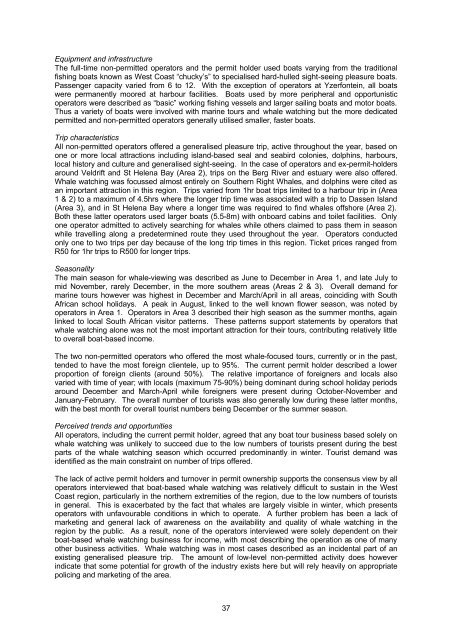Download PDF (2.5MB) - Anchor Environmental
Download PDF (2.5MB) - Anchor Environmental
Download PDF (2.5MB) - Anchor Environmental
Create successful ePaper yourself
Turn your PDF publications into a flip-book with our unique Google optimized e-Paper software.
Equipment and infrastructure<br />
The full-time non-permitted operators and the permit holder used boats varying from the traditional<br />
fishing boats known as West Coast “chucky’s” to specialised hard-hulled sight-seeing pleasure boats.<br />
Passenger capacity varied from 6 to 12. With the exception of operators at Yzerfontein, all boats<br />
were permanently moored at harbour facilities. Boats used by more peripheral and opportunistic<br />
operators were described as “basic” working fishing vessels and larger sailing boats and motor boats.<br />
Thus a variety of boats were involved with marine tours and whale watching but the more dedicated<br />
permitted and non-permitted operators generally utilised smaller, faster boats.<br />
Trip characteristics<br />
All non-permitted operators offered a generalised pleasure trip, active throughout the year, based on<br />
one or more local attractions including island-based seal and seabird colonies, dolphins, harbours,<br />
local history and culture and generalised sight-seeing. In the case of operators and ex-permit-holders<br />
around Veldrift and St Helena Bay (Area 2), trips on the Berg River and estuary were also offered.<br />
Whale watching was focussed almost entirely on Southern Right Whales, and dolphins were cited as<br />
an important attraction in this region. Trips varied from 1hr boat trips limited to a harbour trip in (Area<br />
1 & 2) to a maximum of 4.5hrs where the longer trip time was associated with a trip to Dassen Island<br />
(Area 3), and in St Helena Bay where a longer time was required to find whales offshore (Area 2).<br />
Both these latter operators used larger boats (5.5-8m) with onboard cabins and toilet facilities. Only<br />
one operator admitted to actively searching for whales while others claimed to pass them in season<br />
while travelling along a predetermined route they used throughout the year. Operators conducted<br />
only one to two trips per day because of the long trip times in this region. Ticket prices ranged from<br />
R50 for 1hr trips to R500 for longer trips.<br />
Seasonality<br />
The main season for whale-viewing was described as June to December in Area 1, and late July to<br />
mid November, rarely December, in the more southern areas (Areas 2 & 3). Overall demand for<br />
marine tours however was highest in December and March/April in all areas, coinciding with South<br />
African school holidays. A peak in August, linked to the well known flower season, was noted by<br />
operators in Area 1. Operators in Area 3 described their high season as the summer months, again<br />
linked to local South African visitor patterns. These patterns support statements by operators that<br />
whale watching alone was not the most important attraction for their tours, contributing relatively little<br />
to overall boat-based income.<br />
The two non-permitted operators who offered the most whale-focused tours, currently or in the past,<br />
tended to have the most foreign clientele, up to 95%. The current permit holder described a lower<br />
proportion of foreign clients (around 50%). The relative importance of foreigners and locals also<br />
varied with time of year; with locals (maximum 75-90%) being dominant during school holiday periods<br />
around December and March-April while foreigners were present during October-November and<br />
January-February. The overall number of tourists was also generally low during these latter months,<br />
with the best month for overall tourist numbers being December or the summer season.<br />
Perceived trends and opportunities<br />
All operators, including the current permit holder, agreed that any boat tour business based solely on<br />
whale watching was unlikely to succeed due to the low numbers of tourists present during the best<br />
parts of the whale watching season which occurred predominantly in winter. Tourist demand was<br />
identified as the main constraint on number of trips offered.<br />
The lack of active permit holders and turnover in permit ownership supports the consensus view by all<br />
operators interviewed that boat-based whale watching was relatively difficult to sustain in the West<br />
Coast region, particularly in the northern extremities of the region, due to the low numbers of tourists<br />
in general. This is exacerbated by the fact that whales are largely visible in winter, which presents<br />
operators with unfavourable conditions in which to operate. A further problem has been a lack of<br />
marketing and general lack of awareness on the availability and quality of whale watching in the<br />
region by the public. As a result, none of the operators interviewed were solely dependent on their<br />
boat-based whale watching business for income, with most describing the operation as one of many<br />
other business activities. Whale watching was in most cases described as an incidental part of an<br />
existing generalised pleasure trip. The amount of low-level non-permitted activity does however<br />
indicate that some potential for growth of the industry exists here but will rely heavily on appropriate<br />
policing and marketing of the area.<br />
37
















